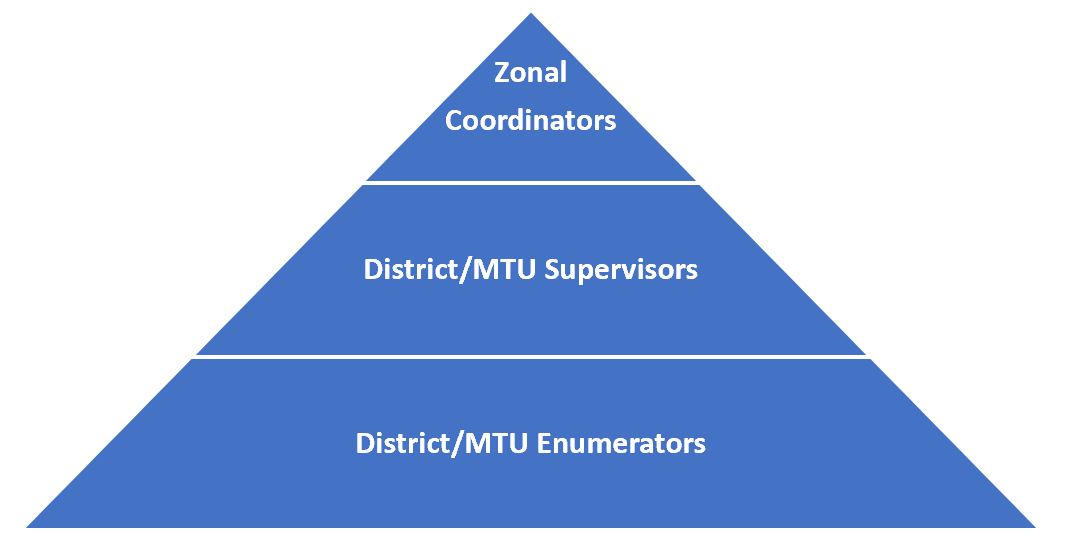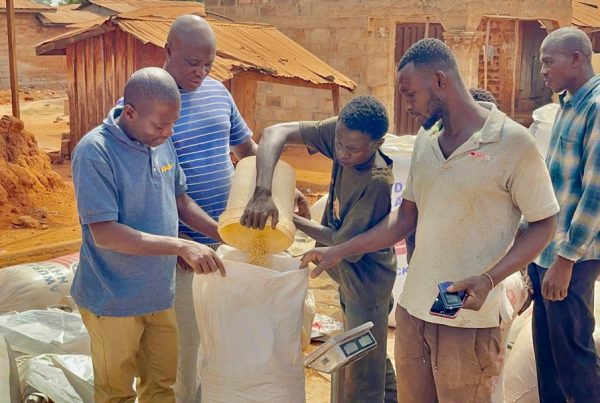Esoko provides a web/mobile-based platform and deployment service called Insyt, for the collection of field data, using tablet devices and smartphones. Since 2013, Insyt has been deployed for several data collection projects including the Livelihood Empowerment Against Poverty Program (LEAP), Ghana Household Registry (GNHR) and Planting for Food and Jobs Program. All these programs are social protection and agriculture related initiatives generally targeted at rural or peri-urban poor communities. In addition to this experience, the company has continued to collect market price data from across Africa since its inception.
Many lessons have been learnt during these 10 years – culminating in this field deployment guide. This guide summarizes Esoko’s best practices for deploying field agents for any kind of data collection exercise using digital devices. It describes processes in agent recruitment and training, data collection approaches, roles of field agents and reporting structure, and monitoring and evaluation of data collection projects. Esoko recommends the use of the Insyt data collection web/mobile platform, which is available for free use via https://insyt.esoko.com.
1. Project Meetings
It is important to schedule regular meeting times with key stakeholders of the data collection exercise – this should include the project manager, finance manager, HR, a client representative where applicable and key field staff. Project meetings are encouraged at the start, middle and end of the data collection exercise to ensure all parties are on the same page with respect to issues such as:
- Open invoices/payments
- Operational plan and challenges
- Data transmission from field to servers and back to the field
- Post review analysis of received data from the field
- Project closing conditions and timelines
- Client expectations
2. Recruiting the right field staff
Getting an enumeration team, which is professional, technologically savvy, and most importantly able to live and work in rural settings is very critical for the success of a data collection exercise. Based on discussions with the project team regarding operational plan during meetings, the total number of field agents and time for the recruitment is agreed.
The following issues, strategies and approaches have helped Esoko recruit and retain top quality field staff:
2.1 Radio advert and online advert posting
Radio and online advertisement are good ways of scouting for candidates to form your enumeration team. Always engage the services of local radio stations which are widely listened to within the project location. Also publish job descriptions on online job portals and project websites where possible.
2.2 Job description and roles of field staff
A well-constructed job description will yield the best results when searching for applicants. Based on our experience, the following job descriptions are recommended for the recruitment process – however, these may vary depending on the scope of the project:
- Zonal Coordinators: Responsible for managing all enumeration activities within their zone.
- District/Mobile Targeting Unit (MTU) Supervisor: They are the first line of support for all field MTUs and enumerators
- District/MTU Enumerator: An enumerator is responsible for managing and collecting data from respondents in the field
2.3 Screening and interviewing process
Candidates who send in their applications should be vetted if they have the required qualifications for the positions they apply for. Qualified candidates should be contacted via email, SMS or phone to participate in the interview process on the said date and time. The main criteria for selecting field staff during the interview are, and not limited to:
- Fluency in speaking the local dialect
- How well a candidate can translate English into the local dialect
- How familiar a candidate is with the use of tablets and its functionality
- Candidates ability to think through a practical and typical registration center problem
- How well candidate know the geographical locations of the district
2.4 Field management structure
The management structure of a data collection project will vary greatly depending upon the scope of project and design. Typically, for large-scale projects, the field team plan structure presented in the diagram below should be considered for both Mobile Targeting Unit (MTU) and Census approaches. The number of field staff increases in the descending order depending on the scale and geographical distribution of targeted communities:


3. Training field staff
Field staff training is a crucial element of collecting high quality data. Regardless of how well designed a data collection instrument and software application is, the quality of data collected depends ultimately on the data collection skills of the enumerators who conduct the interviews, as well as enumeration supervisors. Thorough training ensures that:
- Enumerators fully understand the objectives of the data collection exercise
- Enumerators are familiar with the data collection questionnaire
- Enumerators are confidentially familiar with the data collection device and application
- Enumerators are effective interviewers and can administer the interviews easily, accurately and consistently.
Training schedules should familiarize enumerators with project objectives, understanding and practice of data collection questionnaire, devices and software applications. Prior to conducting the suggested training, the training team together with the client should develop enumerator reference material that should be given to enumerators during the training.
4. Logistics for field staff
The success of mobile field data collection exercises also depends on a well-prepared deployment plan and supporting logistics. Arrangements for field deployment of enumerators and logistics depends on the project scale and geographical distribution. This section briefly outlines the logistics requirement for proper deployment of both MTU and Census enumeration types:
4.1 Planning field work
In a data collection exercise, the first step is to create a field implementation plan that will essentially be a formal document that describes the work activities, deliverables, timelines, quality requirements, terms and conditions, team responsibilities, enumerator targets, budget etc.
4.2 Procuring hardware (mobile phones, tablets or PDAs)
Certain considerations are to be made when choosing hardware for data collection:
- Screen size: A 7-inch size device is generally recommended as it has a sizeable screen and is also easy to handle.
- Features: A good camera to take quality photos and the ability to take very accurate GPS coordinates and finger prints is necessary.
- Battery: Consider choosing devices which can last for about 6 to 8 hours after a full charge.
Note that hardware and software are interrelated. Different hardware comes with different operating systems, supporting different software platforms. The current Insyt software runs on the Android operating system.
4.3 Training logistics
All items needed for successful training of field staff must be procured in advance before the schedule dates. This include note pads, pens, projector(s) and printed copies of enumerators manual. Convenient and easily accessible training venues, accommodation for trainers and enumerators, snacks and lunch must also be arranged in advance before training dates. It is advisable to always choose training venues that are central to enumerators locations, to avoid long distant travels to training centers. Also, consider the internet connectivity at the training venues since t is needed during the training sessions.
4.4 Enumeration costumes
The provision of T-shirts, boots and raincoat for field staff is important purposely for identification and safety of field staff. Depending on the project, field staff should be supplied with: customized t-shirts for identification, boots and raincoat where enumerators do a lot of walking and project banners to identify Mobile Targeting Units (MTUs).
4.5 Transport arrangement and accommodation
Transportation arrangements and a budget for fuel, maintenance and repairs must be made to ensure enumeration teams are always on schedule. This will guarantee high-quality and timely data collection. Vehicles and motor cycles should be made available to field staff to support efficient movement.
4.6 Setting up enumeration teams
Based on the type of data collection exercise and the preference of the client, two forms of team set up can be used. These two approaches are the:
- Mobile Targeting Unit/ Mobile Registration Center
In an MTU enumeration approach, a center (mostly the usually adopted meeting place of community members) within the assigned community is chosen for enumerators while respondents come in turns to be interviewed.
- Census Approach
In this approach, enumerators move from house to house to interview respondents. Sensitization is very key in this enumeration set-up, and supervisors are to play a key role in ensuring households are aware of the presence of the enumeration team in their neighborhood.
Irrespective of the approach chosen in a data collection exercise:
- Consider technological abilities when hiring enumerators. If the data collection team isn’t comfortable with mobile-phone technology, plan to spend significant time training on the devices
- Ensure enumerators store devices securely when not in use. When in use, keep a system to track who is responsible for which device
- Also consider providing appropriate protective covers and water proof back packs for the device to ensure safety throughout the exercise
- Plan and budget to provide a sim card and periodic data credit for internet connectivity for each device in use. For a longer enumeration exercise, a monthly subscription of internet connectivity data is recommended.
5. Monitoring and Evaluation (M&E)
Monitoring and Evaluation at all levels is crucial to ensure the successful implementation of data collection exercises. M&E enhances transparency, accountability, public confidence and enables corrective measures to be put in place to improve project performance. The project manager must design M&E indicators to check the performance of the enumeration exercise. These indicators should be designed to the needs and requirements identified during the project implementation.
6. Reporting
It is very important that individuals in supervisory roles write and submit reports on the enumeration exercise. This provides the project manager a high-level overview on occurrences at various locations and levels of the assignment. A weekly report should be submitted by district and zonal coordinators to the project manager, as well as a daily report submitted by supervisors to their respective coordinators.


